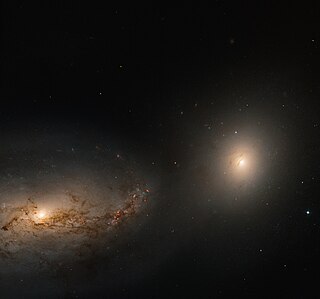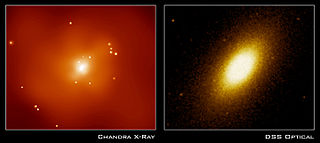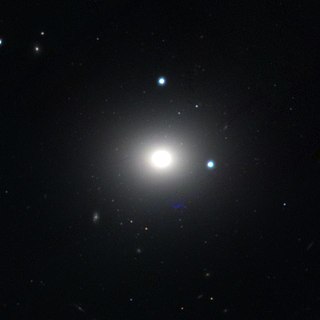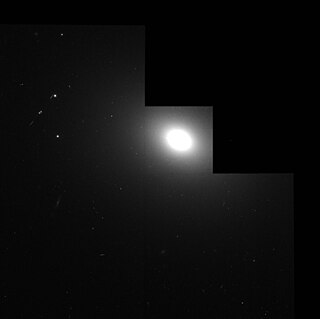An active galactic nucleus (AGN) is a compact region at the center of a galaxy that emits a significant amount of energy across the electromagnetic spectrum, with characteristics indicating that this luminosity is not produced by the stars. Such excess, non-stellar emissions have been observed in the radio, microwave, infrared, optical, ultra-violet, X-ray and gamma ray wavebands. A galaxy hosting an AGN is called an active galaxy. The non-stellar radiation from an AGN is theorized to result from the accretion of matter by a supermassive black hole at the center of its host galaxy.

Seyfert galaxies are one of the two largest groups of active galaxies, along with quasar host galaxies. They have quasar-like nuclei with very high surface brightnesses whose spectra reveal strong, high-ionisation emission lines, but unlike quasars, their host galaxies are clearly detectable.

Messier 87 is a supergiant elliptical galaxy in the constellation Virgo that contains several trillion stars. One of the largest and most massive galaxies in the local universe, it has a large population of globular clusters—about 15,000 compared with the 150–200 orbiting the Milky Way—and a jet of energetic plasma that originates at the core and extends at least 1,500 parsecs, traveling at a relativistic speed. It is one of the brightest radio sources in the sky and a popular target for both amateur and professional astronomers.

The Sombrero Galaxy is a peculiar galaxy of unclear classification in the constellation borders of Virgo and Corvus, being about 9.55 megaparsecs from the Milky Way galaxy. It is a member of the Virgo II Groups, a series of galaxies and galaxy clusters strung out from the southern edge of the Virgo Supercluster. It has an isophotal diameter of approximately 29.09 to 32.32 kiloparsecs, making it slightly bigger in size than the Milky Way.

Messier 89 is an elliptical galaxy in the constellation Virgo. It was discovered by Charles Messier on March 18, 1781. M89 is a member of the Virgo Cluster of galaxies.

NGC 3227 is an intermediate spiral galaxy that is interacting with the dwarf elliptical galaxy NGC 3226. The two galaxies are one of several examples of a spiral with a dwarf elliptical companion that are listed in the Atlas of Peculiar Galaxies. Both galaxies may be found in the constellation Leo. It is a member of the NGC 3227 Group of galaxies, which is a member of the Leo II Groups, a series of galaxies and galaxy clusters strung out from the right edge of the Virgo Supercluster.

NGC 3226 is a dwarf elliptical galaxy that is interacting with the spiral galaxy NGC 3227. The two galaxies are one of several examples of a spiral with a dwarf elliptical companion that are listed in the Atlas of Peculiar Galaxies. Both galaxies may be found in the constellation Leo. It is a member of the NGC 3227 Group of galaxies, which is a member of the Leo II Groups, a series of galaxies and galaxy clusters strung out from the right edge of the Virgo Supercluster.

NGC 1553 is a prototypical lenticular galaxy in the constellation Dorado. It is the second brightest member of the Dorado Group of galaxies. British astronomer John Herschel discovered NGC 1553 on December 5, 1834 using an 18.7 inch reflector.

Maffei 1 is a massive elliptical galaxy in the constellation Cassiopeia. Once believed to be a member of the Local Group of galaxies, it is now known to belong to a separate group, the IC 342/Maffei Group. It was named after Paolo Maffei, who discovered it and the neighboring Maffei 2 in 1967 via their infrared emissions.

NGC 6166 is an elliptical galaxy in the Abell 2199 cluster. It lies 490 million light years away in the constellation Hercules. The primary galaxy in the cluster, it is one of the most luminous galaxies known in terms of X-ray emissions.

NGC 3610 is an elliptical galaxy in the constellation Ursa Major. It was discovered on 8 April 1793 by German-British astronomer William Herschel. This galaxy is located at a distance of 106 million light-years (32.5 Mpc) from the Milky Way, and is receding with a galacto-centric radial velocity of 1,819 km/s.

NGC 4478 is an elliptical galaxy located about 50 million light-years away in the constellation Virgo. NGC 4478 was discovered by astronomer William Herschel on April 12, 1784. NGC 4478 is a member of the Virgo Cluster.

NGC 708 is an elliptical galaxy located 240 million light-years away in the constellation Andromeda and was discovered by astronomer William Herschel on September 21, 1786. It is classified as a cD galaxy and is the brightest member of Abell 262. NGC 708 is a weak FR I radio galaxy and is also classified as a type 2 Seyfert galaxy.

NGC 720 is an elliptical galaxy located in the constellation Cetus. It is located at a distance of circa 80 million light years from Earth, which, given its apparent dimensions, means that NGC 720 is about 110,000 light years across. It was discovered by William Herschel on October 3, 1785. The galaxy is included in the Herschel 400 Catalogue. It lies about three and a half degrees south and slightly east from zeta Ceti.

NGC 7469 is an intermediate spiral galaxy in the constellation of Pegasus. NGC 7469 is located about 200 million light-years away from Earth, which means, given its apparent dimensions, that NGC 7469 is approximately 90,000 light-years across. It was discovered by William Herschel on November 12, 1784.

NGC 1395 is an elliptical galaxy located in the constellation Eridanus. It is located at a distance of circa 75 million light years from Earth, which, given its apparent dimensions, means that NGC 1395 is about 130,000 light years across. It was discovered by William Herschel on November 17, 1784. It is a member of the Eridanus Cluster.

NGC 4636 is an elliptical galaxy located in the constellation Virgo. It is a member of the NGC 4753 Group of galaxies, which is a member of the Virgo II Groups, a series of galaxies and galaxy clusters strung out from the southern edge of the Virgo Supercluster. It is located at a distance of about 55 million light years from Earth, which, given its apparent dimensions, means that NGC 4636 is about 105,000 light years across.

NGC 5846 is an elliptical galaxy located in the constellation Virgo. It is located at a distance of circa 90 million light years from Earth, which, given its apparent dimensions, means that NGC 5846 is about 110,000 light years across. It was discovered by William Herschel on February 24, 1786. It lies near 110 Virginis and is part of the Herschel 400 Catalogue. It is a member of the NGC 5846 Group of galaxies, itself one of the Virgo III Groups strung out to the east of the Virgo Supercluster of galaxies.

IC 1459 is an elliptical galaxy located in the constellation Grus. It is located at a distance of circa 85 million light-years from Earth, which, given its apparent dimensions, means that IC 1459 is about 130,000 light-years across. It was discovered by Edward Emerson Barnard in 1892.

NGC 1142 is a distorted spiral galaxy in the constellation of Cetus. It is located about 370 million light years away from Earth, which means, given its apparent dimensions, that NGC 1142 is approximately 170,000 light years across. It is a type 2 Seyfert galaxy. It interacts with the elliptical galaxy NGC 1141.




















